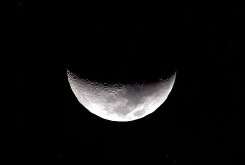NASA: Good night moon, hello new rocket technology

(AP) -- President Barack Obama is redirecting America's space program, killing NASA's $100 billion plans to return astronauts to the moon and using much of that money for new rocket technology research.
The moon plan, which NASA had already spent $9.1 billion on, was based on old technology and revisiting old places astronauts had already been, officials said. The previous NASA chief, in selling the old moon plan, had even called it "Apollo on steroids." The rockets were based on space shuttle boosters.
"Simply put, we're putting the science back into the rocket science at NASA," White House science adviser John Holdren said at a budget briefing Monday.
The $4 billion that NASA spends yearly on human space exploration will now be used for what NASA and White House officials called dramatic changes in rocketry, including in-orbit fueling. They said eventually those new technologies would be used to send astronauts to a nearby asteroid, a brief foray back to the moon, or the Martian moons.
The White House plan was short on details, such as where astronauts would fly next, on what type of rocketship, or when. However, officials were quick to point out the failures of the Bush administration's moon program, called Constellation. It included the construction of two types of rockets, Ares I and Ares V, and an Orion crew capsule. All were canceled. Shutting down the program will cost about $2.5 billion, NASA said.
Former President George W. Bush proposed the moon mission after the Feb. 1, 2003, space shuttle Columbia disaster that claimed seven lives - exactly seven years ago Monday.
Besides redirecting money to new technologies, NASA is getting an extra $6 billion over five years to encourage companies to build private spaceships that NASA could rent. Many of those companies are run by Internet pioneers. The companies included in the pilot project include Blue Origin, which is run by Amazon founder Jeff Bezos. Another firm already building private rockets is run by PayPal founder Elon Musk.
NASA will also spend an additional $2.5 billion over five years for more research on how global warming is affecting Earth, including replacing a carbon dioxide monitoring satellite that crashed last year. NASA will also extend the life by several years of the International Space Station, which had been slated for retirement in 2016. NASA's yearly budget is $19 billion.
NASA said if the private companies work well on their unproven spaceships, astronauts could fly in them to the space station as soon as 2016. After the next five space shuttle flights, NASA will have to hitch rides to the space station on Russian rockets.
"The truth is we were not on a sustainable path to get back to the moon," NASA administrator Charles Bolden said in a telephone conference call. "We were neglecting investments in key technologies."
Congressional officials howled over lost programs and jobs, but it is hard for Congress to save such a large program that is being cut with redistributed money.
Sen. Richard Shelby, R-Ala., called the cancellation of the moon program the "death march for the future of U.S. human space flight."
©2010 The Associated Press. All rights reserved. This material may not be published, broadcast, rewritten or redistributed.
















